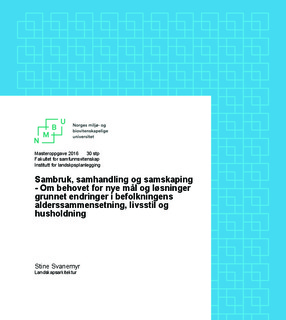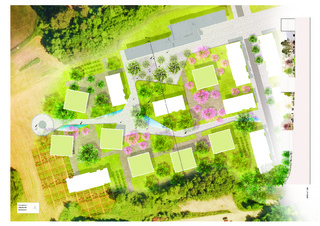| dc.contributor.advisor | Rivera, Agustin Sebastian | |
| dc.contributor.author | Svanemyr, Stine | |
| dc.coverage.spatial | Norway, Asker, Billingstad | nb_NO |
| dc.date.accessioned | 2017-04-06T11:42:14Z | |
| dc.date.available | 2017-04-06T11:42:14Z | |
| dc.date.issued | 2016 | |
| dc.identifier.uri | http://hdl.handle.net/11250/2437003 | |
| dc.description.abstract | Vi blir flere eldre og vi blir eldre enn før. Kombinasjonen av at vi gjennomsnittlig lever stadig lenger og at de store etterkrigskullene nærmer seg alderdommen, gjør at vi i løpet av 2030-2035 vil få en markant endring i alderssammensetningen. Den endrede alderssammensetningen vil gi et skjevt størrelseforhold mellom antallet eldre og antallet yrkesaktive som kan yte dem omsorg. Vi vil få store utfordringer knyttet til økt eldreomsorgsbyrde, derav begrepet eldrebølge.
Omsorgskrisen skapes dog ikke av eldrebølgen, men av forestillingen om at omsorg ikke kan gjøres annerledes enn i dag. Vi må i framtiden basere oss på fellesskapsløsninger i mellomrommet mellom offentlig virksomhet og sivilsamfunn.
Visst ligger det store utfordringer i aldringen av befolkningen, men også store muligheter, om vi bare ser etter.Framtidens eldre vil møte alderdommen med helt andre ressurser enn dagens eldre. De vil blant annet ha bedre helse, langt høyere utdanning og bedre økonomi. De vil i større grad enn i dag være selvgående og i stand til å ta hånd om seg selv. Modernismen har manet frem holdninger og verdier som omhandler selvrealisering, mestring og uavhengighet. Morgendagens eldre vil skille seg fra dagens eldre, som kjennetegnes mer av konformitet og tradisjonsorienterte verdier.
Demografiske konsekvenser av individualiseringen viser seg dessuten som markant fall i fruktbarhet, utsatte ekteskap, samboerskap framfor ekteskap og skillsmisse. Husholdningene blir stadig mindre og enpersonshusholdningene øker.
Jeg tror at utfordringene og mulighetene vi står overfor langt på vei kan løses med utgangspunkt i hverandre. Økt eldreomsorgsbyrde, flere aleneboende eldre og enslige forsørgere i kombinasjon med, på den annen side, ressursene og behovene til de nye eldre, tegner bildet av et avhengighetsforhold med mulighet for gjensidig vinning. Vi må kople oss på hverandre og på oss selv.
Jeg vil argumentere for at vi gjennom våre fysiske løsninger må strebe etter å tilrettelegge for, og utfordre til, aktiv deltakelse, medansvar, medborgerskap, samhandling, samskaping og uformell omsorg. Ikke bare handler dette om å løse helse- og omsorgsutfordringen. Det vil gi gode omgivelser for alle aldersgrupper og handler om hva slags framtidssamfunn vi vil bygge.
På Billingstad i Asker skal et større næringsområde transformeres til bolig som et resultat av den overordnede føringen om knutepunktfortetting, en del av bybånd-strategien. Fortettingen må skje slik kommunen forespeiler det; med kvalitet, møteplasser og nytt nærsenter. I tillegg til disse klassiske premissene mener jeg at også en annen og større dimensjon må legge føringer for utbyggingen, nemlig den som omhandler de unektelige befolkningsendringene knyttet til alderssammensetning, livsstil og husholdning. Utbyggingen som skal skje på nedre Billingstad er den største i Askers historie og den må gi rom for innovative løsninger som et resultat av befolkningens endrede fremtidige behov. På bakgrunn av endringene beskrevet må det settes konkrete mål som omhandler og støtter oppom det mellommenneskelige og medmenneskelige, og disse må igjen synliggjøres i de fysiske planene. Jeg har gjort en mulighetsstudie for en del av det aktuelle transformasjonsområdet på Billingstad. Løsningen må forstås som et forprosjekt der ambisjonen er å vise hvordan det fysiske kan tilrettelegge for sambruk, samhandling og samskaping. | nb_NO |
| dc.description.abstract | The Norwegian population is facing severe changes as the number of elderly people increases and so does also life expectancy. The combination of an ever longer living, and the approaching large post-war generation facing older age, will cause a distinct change in our populations age structure by the years of 2030-2035.
The changes in age structure within the population will cause displacement between the number of elderly and the number of gainfully employed that can provide care. We will be facing considerable challenges from this increasing number of elderly in need of care – and this is the meaning that we have been learned to understand from the consept “wave-of-elderly”.
A care crisis is not being created by the wave-of-elderly itself, but from the anticipation that human care can not be provided otherwise than like nowadays. In the future we will have to rely on joint venture solutions that lies in the gap between public service and sivil society.
Certainly there are substantial challenges coming from the fact of the aging population, but there are also lying great opportunities, if we look for them. Future elderly will face old age with quite different resources than those elderly of today. Among other things, they will be of better health, higher education and by better economy. They will increasingly than today be self-supporting and able to take care of themselves. Modernism has conjured up attitudes and values about self-realization, mastering and independence. The elderly of tomorrow will deviate from todays elderly, who are recognized by more extensive passivity, conformity and values based on tradition.
Demographic consequences from individualization is furthermore coming as result from distinct fall in fertility, postponement of marriage, cohabitation and divorce. Households are ever getting smaller and single-person households are increasing.
I think that the challenges and the opportunities we are facing can largely be solved based on interaction from each other. Increase in elderly care, several single elderly and single parents – in combination with, on the other hand, the resources and needs of the new type of elderly, draws the picture of a dependency with potential for mutual gain. We must connect us to each other. I will argue that we through our physical solutions must aspire, facilitate and challenge to active participation, responsibility, citizenship, interaction, co-creating and informal care. Not only is this a matter of solving the challenge within health and care. It will provide effective surroundings for people of all ages, and it is about what kind of future society we want to build.
In the area of Billingstad, in the municipality of Asker, a larger industrial area is ahead of transforming into residential, as a result of superior strategy and planning for densification along traffic nodes around the capital of Oslo. According to the municipality the densification must be developed with quality, meeting points and new local daily services. In addition to these classical premises, I see the need of bringing in another conciderable premise for the development; in fact the one dealing with the consequences from population changes linked to age structure, household and lifestyle. The development project in Billingstad is going to be the largest in the history of Asker, and as our populations needs changes the project must allow for innovative solutions. Based on the changes described, specific aims must be set and visualized in the physical plan, to support between humanity and compassion. I have made a feasibility study for one part of the current transforming zone in Billingstad. The solution must be regarded as a preliminary project where the ambition is just to visualize how the physical planning can facilitate co-benefit, interaction and co-creating. | nb_NO |
| dc.language.iso | nob | nb_NO |
| dc.publisher | Norwegian University of Life Sciences, Ås | nb_NO |
| dc.rights | Attribution-NonCommercial-NoDerivatives 4.0 Internasjonal | * |
| dc.rights.uri | http://creativecommons.org/licenses/by-nc-nd/4.0/deed.no | * |
| dc.title | Sambruk, samhandling og samskaping : om behovet for nye mål og løsninger grunnet endringer i befolkningens alderssammensetning, livsstil og husholdning | nb_NO |
| dc.type | Master thesis | nb_NO |
| dc.subject.nsi | VDP::Social science: 200::Urbanism and physical planning: 230 | nb_NO |
| dc.source.pagenumber | 126 | nb_NO |
| dc.description.localcode | M-LA | nb_NO |


